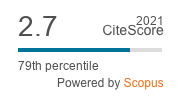Mathematical modeling and optimization of intelligent systems using a hybrid PSO-GWO algorithm: A minx J(x) approach
Keywords:
Intelligent systems; Optimization algorithms; PSO; GWO; Hybrid PSO-GWO.Abstract
In this paper, a comparative analysis of Particle Swarm Optimization (PSO), Grey Wolf Optimization (GWO), and a hybrid PSO-GWO algorithm for the solution of complex optimization problems have been presented. The hybrid algorithm consists of the exploitation strength of GWO and the exploration capabilities of PSO while combining both together to surmount the failure of standalone algorithms like slow convergence in GWO and premature convergence in the PSO. The algorithms were evaluated in terms of convergence speed, robustness, and accuracy, on a series of benchmark functions (Sphere, Rastrigin, Ackley, Rosenbrock, and Griewank). The results of simulations indicate that the notion of a hybrid PSO-GWO algorithm is always better compared to standalone PSO as well as GWO for lower mean square errors (MSE) and quicker convergence to global optimum for different optimization landscapes. Finally, the hybrid approach took advantage of the best in all three aspects to optimize multimodal, non-convex, and deceptive functions with both reliable and robust performance that was superior to that of local minimum avoidance algorithms. This research shows that the hybrid PSO-GWO algorithm is an efficient tool for robust optimization in the real-world systems of dynamic, complex systems. Future work is to extend the algorithm’s adaptability to real-world constraints, and dynamic parameter adjustment, and integrate it within domain-specific heuristics to improve the optimization in engineering and automation tasks.
References
A. Zaghwan, Y. Amer, M. Efatmaneshnik, and I. Gunawan, “Advancing System of Systems Engineering using intangible value logic measurements from Intellectual Capital Thinking Approach,” Heliyon, vol. 10, no. 21, Nov. 2024. doi: 10.1016/j.heliyon.2024.e39814.
M. Habibullah, K. N. Bhumkittipich, N. Mithulananthan, R. Sharma and F. Zare, “Damping Oscillation and Removing Resonance in a RE Based DC Microgrids,” in IEEE Access, vol. 9, pp. 163516-163525, 2021, doi: 10.1109/ACCESS.2021.3135033.
Y. Zeng, B. Liao, Z. Li, C. Hua and S. Li, “A Comprehensive Review of Recent Advances on Intelligence Algorithms and Information Engineering Applications,” in IEEE Access, vol. 12, pp. 135886-135912, 2024, doi: 10.1109/ACCESS.2024.3461756.
N. Basil and H. M. Marhoon, “Selection and evaluation of FOPID criteria for the X-15 adaptive flight control system (AFCS) via Lyapunov candidates: Optimizing trade-offs and critical values using optimization algorithms,” e-Prime-Advances Electr. Eng. Electron. Energy, vol. 6, p. 100305, 2023.
F. S. Raheem and N. Basil, “Automation intelligence photovoltaic system for power and voltage issues based on Black Hole Optimization algorithm with FOPID,” Meas. Sensors, vol. 25, p. 100640, 2023.
N. Gideon Ude, H. Yskandar and R. Coneth Graham, “A Comprehensive State-of-the-Art Survey on the Transmission Network Expansion Planning Optimization Algorithms,” in IEEE Access, vol. 7, pp. 123158-123181, 2019, doi: 10.1109/ACCESS.2019.2936682.
N. Basil and H. M. Marhoon, “Towards evaluation of the PID criteria based UAVs observation and tracking head within resizable selection by COA algorithm,” Results Control Optim., vol. 12, p. 100279, 2023.
H. M. Marhoon, N. Basil, and A. F. Mohammed, “Medical Defense Nanorobots (MDNRs): a new evaluation and selection of controller criteria for improved disease diagnosis and patient safety using NARMA(L2)-FOP+D(ANFIS)µ – Iλ-based Archimedes Optimization Algorithm,” Int. J. Inf. Technol., 2024, doi: 10.1007/s41870-023-01724-7.
A. F. Mohammed et al., “Selection and Evaluation of Robotic Arm based Conveyor Belts (RACBs) Motions: NARMA (L2)-FO (ANFIS) PD-I based Jaya Optimization Algorithm,” Int. J. Robot. Control Syst., vol. 4, no. 1, pp. 262–290, 2024.
J. Tang, G. Liu and Q. Pan, “A Review on Representative Swarm Intelligence Algorithms for Solving Optimization Problems: Applications and Trends,” in IEEE/CAA Journal of Automatica Sinica, vol. 8, no. 10, pp. 1627-1643, October 2021, doi: 10.1109/JAS.2021.1004129.
N. B. Mohamadwasel and S. Kurnaz, “Implementation of the parallel robot using FOPID with fuzzy type-2 in use social spider optimization algorithm,” Appl. Nanosci., pp. 1–11, 2021, doi: 10.1007/s13204-021-02034-9.
N. Basil and A. Ma’arif, “NB Theory with Bargaining Problem: A New Theory,” Int. J. Robot. Control Syst., vol. 2, no. 3, 2022.
A. Rego, P. L. Ramírez, J. M. Jimenez, and J. Lloret, “Artificial Intelligent System for multimedia services in Smart Home Environments,” Cluster Computing, vol. 25, no. 3, pp. 2085–2105, Jul. 2021. doi: 10.1007/s10586-021-03350-z.
A. F. Mohammed, H. M. Marhoon, N. Basil, and A. Ma’arif, “A New Hybrid Intelligent Fractional Order Proportional Double Derivative+ Integral (FOPDD+ I) Controller with ANFIS Simulated on Automatic Voltage Regulator System,” Int. J. Robot. Control Syst., vol. 4, no. 2, pp. 463–479, 2024.
N. Basil and H. M. Marhoon, “Correction to: selection and evaluation of FOPID criteria for the X-15 adaptive flight control system (AFCS) via Lyapunov candidates: Optimizing trade-offs and critical values using optimization algorithms,” e-Prime-Advances Electr. Eng. Electron. Energy, vol. 8, p. 100589, 2024.
N. Basil, B. M. Sabbar, H. M. Marhoon, A. F. Mohammed, and A. Ma’arif, “Systematic Review of Unmanned Aerial Vehicles Control: Challenges, Solutions, and Meta-Heuristic Optimization,” Int. J. Robot. Control Syst., vol. 4, no. 4, pp. 1794–1818, 2024.
A. K. Mishra, S. R. Das, P. K. Ray, R. K. Mallick, A. Mohanty and D. K. Mishra, “PSO-GWO Optimized Fractional Order PID Based Hybrid Shunt Active Power Filter for Power Quality Improvements,” in IEEE Access, vol. 8, pp. 74497-74512, 2020, doi: 10.1109/ACCESS.2020.2988611.
Duan, B., Guo, C. & Liu, H., “A hybrid genetic-particle swarm optimization algorithm for multi-constraint optimization problems”, Soft Computing, vol. 26, pp.11695–11711, 2022, doi: 10.1007/s00500-022-07489-8.
Gharehchopogh, F.S., “An Improved Harris Hawks Optimization Algorithm with Multi-strategy for Community Detection in Social Network”, J Bionic Eng, vol. 20, pp. 1175–1197, 2023, doi: 10.1007/s42235-022-00303-z.
S. Arora, H. Singh, M. Sharma, S. Sharma and P. Anand, “A New Hybrid Algorithm Based on Grey Wolf Optimization and Crow Search Algorithm for Unconstrained Function Optimization and Feature Selection,” in IEEE Access, vol. 7, pp. 26343-26361, 2019, doi: 10.1109/ACCESS.2019.2897325.
Abbas, M., Alshehri, M. A., & Barnawi, A. B., “Potential Contribution of the Grey Wolf Optimization Algorithm in Reducing Active Power Losses in Electrical Power Systems”, Applied Sciences, vol. 12, no. 12, p. 6177, 2022, doi: 10.3390/app12126177.
Yu, M., Xu, J., Liang, W. et al., “Improved multi-strategy adaptive Grey Wolf Optimization for practical engineering applications and high-dimensional problem solving”, Artif. Intell. Rev., vol.57, p.277, 2024, doi: 10.1007/s10462-024-10821-3.
Y. Zhang and Y. Cai, “Adaptive dynamic self-learning grey wolf optimization algorithm for solving global optimization problems and engineering problems,” Mathematical Biosciences and Engineering, vol. 21, no. 3, pp. 3910–3943, 2024. doi: 10.3934/mbe.2024174.
Yuan, P., Zhang, T., Yao, L., Lu, Y., & Zhuang, W., “A Hybrid Golden Jackal Optimization and Golden Sine Algorithm with Dynamic Lens-Imaging Learning for Global Optimization Problems”, Applied Sciences, vol. 12, no. 19, p. 9709, 2022, doi: 10.3390/app12199709.
Papazoglou, G., & Biskas, P., “Review and Comparison of Genetic Algorithm and Particle Swarm Optimization in the Optimal Power Flow Problem”, Energies, vol. 16, no. 3, p.1152, 2023, doi: 10.3390/en16031152.




